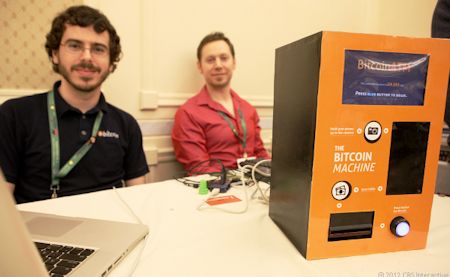|
Matt Whitlock and Zach Harvey of Lamassu Bitcoin Advisors
Here’s the story of Zach Harvey and Matt Whitlock, the young guns behind the latest innovation:
To find wide acceptance, free market currencies need to allow both banking style on-line transactions (mainly for Business to Business transactions) and a more direct mode of payment for Business to Consumer deals.
This ATM device allows B2C transactions in a modern and convenient way and certainly has the potential to greatly impact Bitcoin’s exposure and reach.
Meanwhile, Bitcoin is heavily discussed on all kinds of forums. The general trend seems to be that people more and more appreciate the idea of free market competition in currency. There are some very unfair critiques also, for instance from anarcho-capitalist outlet ‘the Daily Bell’.
One would expect from them more than anybody else to endorse free market innovations, but since it is not Gold, it does not fit in their quaint notions on money. According to them the fact that Bitcoin transactions are logged and are thus traceable is probably the real agenda behind them. They seem to assume we will pay only with coin once nature has run its course.
But this is nonsense, of course, we can’t do without solid on-line transactions in the modern age, not for the time being anyway.
Logging is implicit in on-line banking-style transactions. The problem is not logging, but who is doing the logging and what is he doing with it. There are privacy concerns, and we’ll see if and how the market solves them, but we cannot blame such a revolutionary initiative for not being perfect from day one.
Certainly, a new currency, not centrally controlled by tPtB, a volume far less easily manipulable, showing the free market way, is a step forward.
The fact that 1 Bitcoin is now selling at 30 dollars is quite something: back in November 2011 its price stood at 6 and it’s hard to think of an asset doing better. However, basically this is Bitcoin’s main problem.
As we discussed earlier, Bitcoin is built on the premise that loss of value (‘inflation’) is the main problem with our money. It is not. Scarcity, deflation and usury are our main problems and although I’ve not yet heard of Bitcoin banking initiatives, unavoidably associated with usurious lending, it is only a matter of time.
Bitcoin’s high price and continuing quick appreciation is a very solid indicator that there are not enough in circulation: demand outstrips supply and this will not change. It is also starting to look vulnerable to speculation and market manipulation.
Furthermore, because it is so incredibly lucrative to hold them, people will much prefer to pay with dollars, except for the curiosity effect of paying with Bitcoin. This hoarding aggravates an already deflationary scenario and is very similar to the deflationary depression that we are facing today in the wider economy.
There is also the bizarre story of the CIA’s ‘not for profit investment arm’ (whatever that may mean) IN-Q-TEL eying Bitcoin for ‘investment’.
However, Bitcoin was designed to allow many different parameters. Different versions of it can be designed, with quite different basic rules and there are several spin-offs in development.
One of these is Freicoin, which was recently released and which comes along with a ‘demurrage’: a negative interest rate, charging the holders of money, instead of the borrowers. This promotes spending the money and ends hoarding. People tend to pay as quickly as possible to avoid the, typically about 6% per year, fine.
The legendary Wörgl, operational in 1934 Austria during the darkest days of the Great Depression, is the most famous example of a demurrage currency. Most German regional currencies are equipped with it too.
In Wörgl it ended unemployment within a year and public works were renewing the whole place while the rest of Europe languished. It was so successful, the Austrian Central Bank panicked and closed it down and threatened with a military invasion when the natives got angry. Even today, the basic laws that govern banking in Euroland are explicitly formulated in such a way as to make the basic Wörgl design impossible.
Freicoin’s demurrage will probably solve Bitcoin’s main weakness. It will be interesting to see how it will perform in comparison to Bitcoin. Marketing is very important to unlock its potential.
Conclusion
It is a great inspiration for all monetary reformers out there.
|

